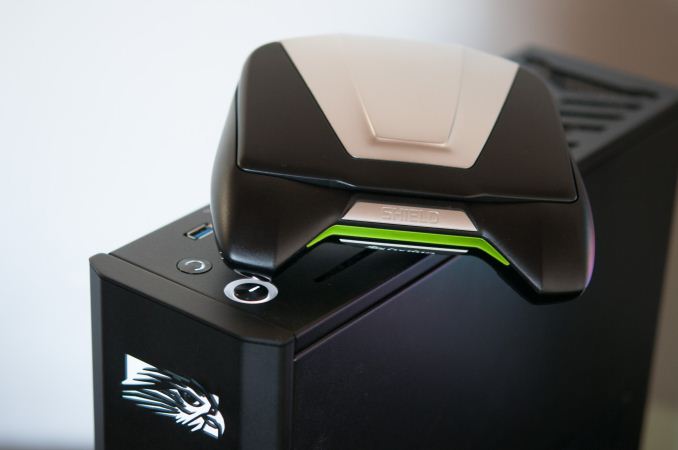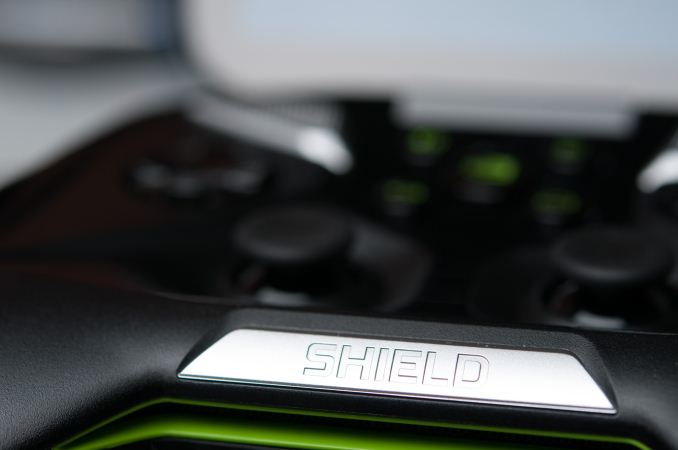NVIDIA Shield Review: At the Crossroads of PC and Mobile Gaming
by Brian Klug on July 31, 2013 12:14 AM ESTI enjoyed the time I spent with NVIDIA Shield. While it isn't perfect, for NVIDIA's first consumer electronic mobile device, it's an amazingly well put together piece of kit. Build quality is so good I told Anand that I wanted to try running it over with my car. I expected NVIDIA to fumble the controller side of the handheld gaming experience, and quite honestly with Shield I have nothing to complain about. The buttons are all tactile and fluid, the analog sticks are great, and the ergonomics leave me without anything to complain about. I remember being worried about weight and balance after seeing Shield and hearing about that the 28.8 watt-hour battery inside, but the shipping device turns all of that mass into feeling like quality rather than a big burden. The one feedback point is what I already gave NVIDIA the first time seeing Shield in person – it needs a bigger 5.5-inch display and 1080p, just buy the LG Display panel used in the LG Optimus G Pro, it's phenomenal. If a smartphone can include that size display, a portable handheld gaming console of this caliber absolutely positively needs it, and that will also help viewing PC gaming content streamed over to Shield. I also strongly believe Shield needs at least a front facing camera, that can't possibly add to the BOM too much.
Is NVIDIA Shield fun to use? It absolutely positively is. Android is still however really nascent as a gaming platform, and I wish that Google had given Shield some sort of extra special status or inclusion in the Android 4.3 love with Google Play Games and Shield as the launch vehicle. Instead it feels like NVIDIA was left to carry Shield on its own here, and that's not their fault, I just wish Google would've put two and two together, maybe a Google Play edition Shield even though it's already running stock Android 4.2.1? The games on Android are fun, there just need to be more of them, and the ones that exist need to of a higher caliber to really sell me. Of course there's always the chicken and egg argument – good Android gaming hardware really wasn't available until recently with set top consoles like Ouya or Android-running HDMI dongles, or of course the handheld format that Shield is. I enjoy playing the titles there are, there's just not quite a killer title you can point to yet.
That's where the PC gaming part comes in, and thank goodness for it. NVIDIA's execution is arguably better than the beta tag implies, with minimal hitching during streaming, impressively low latency, and good support for a number of titles that they've promised will grow. NVIDIA's real strength is on the desktop, and this is the most logical way to leverage it, even if Tegra 4 really becomes something of a thin client in that model. I spent a lot of time enjoying Borderlands 2 from places in my house that are a lot more inviting than the task chair and Ikea desk I sit at all day.
The Tegra 4 part of the story is impressive. Performance on the device is incredibly smooth, I thought I had seen the smoothest possible experience with the latest and greatest quad core SoCs in smartphones, Tegra 4 in this form factor is something to behold. There are parts of some apps I never knew could go so fast. I said in the Nexus 7 review that I wished whatever happened to Tegra 4 that delayed it hadn't, so we could see it in more devices. Shield was a big part of what made me feel that way, especially after seeing and using it in the flesh.
Shield is an impressive product. It's solid, performant, and maybe Android gaming isn't really there yet, but what it does leave me wanting is for NVIDIA to make me a phone.












134 Comments
View All Comments
fr33h33l - Wednesday, July 31, 2013 - link
Nice review as always and good to see Shield and Tegra 4 finally shipping.I am curious though as to what has led to the (so far) low adoption rate of Tegra 4, especially in contrast to the almost performance-wise equivalent Snapdragon 800. Was it just a matter of time-to-market, or was it deal negotiation issues, or as some say (without providing conclusive evidence) that Tegra 4 is inferior to Snapdragon 800 in power efficiency?
Does anyone have more insights (as opposed to unsubstantiated rumors) into this?
Spunjji - Thursday, August 1, 2013 - link
Previously mentioned Amazon reviews for the Toshiba Excite Pro indicate overheating issues and poor battery life. That's not as good as a proper analysis but I'd hesitate to call it unsubstantiated.fteoath64 - Saturday, August 3, 2013 - link
A lot of people are curious about this same question :"Is Tegra 4 is inferior to Snapdragon 800 in power efficiency?". I would agree that it is a yes but not by much. The issue for both chips are that they are overkill (in battery sapping rate) for phone implementation and more suitable for large tablet and console use such as Shield. I think the issue of T4 is its TTM just kills the market opportunity and also the fact that Qualcomm has had multiple solutions to match/counter the old T3 design wins and hence snags them all!. It is a pity for Nvidia but the market is rather brutal due to fierce competition. Even Intel cannot muscle themselves in with the new Atom chip. Not that it is good enough or low priced (huh!). This T4 device at least gives the market some sort of benchmark in comparing its performance in detail over the coming weeks. The S800 tablets are not as forthcoming as we hoped so there is plenty of time to determine some much wanted data.It is interesting to see the SnapDragon S4 Pro chip being used in Nexus 7 and Moto X, new Droid range as well especially when the flagship S600 was doing so well. Is there a radical price difference , I wonder ...
WeaselITB - Wednesday, July 31, 2013 - link
Didn't see it in the review, but I'm curious how well it performs streaming PC game to Shield to HDMI cable plugged into a TV. Cabling get in the way? Problems with battery life in this scenario? How well does the high-res PC compress down to stream to the Shield, then upconvert back to 1080p for the TV? What about transition from sitting on the couch with the cable plugged into the TV, then unplugging the cable to walk into the kitchen, any glitches with transitioning back to the in-device screen?marraco - Wednesday, July 31, 2013 - link
I wish I had a PC client for streaming, so I can run my GTX 670 and play on my laptop/netbookmarraco - Wednesday, July 31, 2013 - link
That would rule out AMD cards for mepandemonium - Thursday, August 1, 2013 - link
I just don't see the point in spending money on a mobile gaming device any more. With all of the smartphones and tablets out there, this is going to be a difficult sell to anyone but the most enthusiastic of fans.Also, my PC is built for gaming and the ecosystem isn't really going anywhere (contrary to popular belief that it's been dying for years and years...). Plus, there's consoles.
It may be awesome, but not for the current day and age. If this came out in 2006, it would've made a killing.
darkhawk1980 - Thursday, August 1, 2013 - link
The only comment I have is that when I played around with this at PAX East 2013, the screen mechanism felt VERY flimsy. I'm not sure if it was because of the fact that these were demo units that were (obviously) very used at that point or what, but I felt like if I closed the screen the hinge would make the screen break in half. It just didn't provide a good feel as it closed, like the hinge was too tight. It reminded me of my MSI GT70's screen at times, where I'm very careful closing it since it is rather delicate.All that aside, it did seem like a good device and was fun to use, but I just don't feel I'd use it as much simply because I enjoy having a tablet for real use.
bertiebond - Thursday, August 1, 2013 - link
so.. its got a screen, it has speakers, it has a a mic, it has wifi..so it just needs 3g and you can stick it next to your ear and start making calls ?D
Spunjji - Thursday, August 1, 2013 - link
SIDETALKIN'